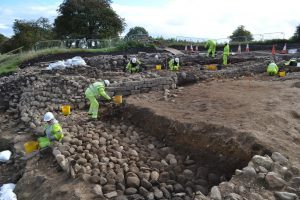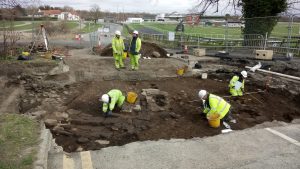Archaeological investigation in an area near Scotch Corner, North Yorkshire, England, scheduled to be overbuilt by the A1 road, unearthed a wealthy Roman settlement and rare artefacts linked to the engineers who built the ancient Dere Street, a Roman road that’s followed by the modern A1.

Archaeologists uncovered the artefacts during a major project to improve the existing roadway. The findings include ancient shoes, cups, a rare silver ring, keys, a high-relief glass bowl, an elaborately carved amber figurine, and a plumb bob used to build straight roads, which was likely utilized in the construction of Dere Street.

The excavations have also led to the discovery of a major Roman settlement at Scotch Corner, one of the best-known junctions in England. The settlement is said to pre-date the settlements at York and Carlisle by 10 years, indicating that the Romans arrived in the Northern England earlier than previously thought. Artefacts unearthed there suggest that the people who lived at Scotch Corner were rather wealthy as high-status imported items were found, including the figure of a toga-clad actor carved from a block of amber, which is believed to have been made in Italy during the first century AD, as it is comparable with a similar example found at Pompeii.

The demise of the settlement seems to coincide with the rise of Catterick, a town south of Scotch Corner known by the Romans as Cataractonium. The artefacts suggest that Cataractonium was an important leatherworking centre that likely supported the Roman military. A rare silver ring shaped like a snake, which wraps around the finger, and a number of keys of various sizes suggest that the people who lived in the newly discovered settlement and Cataractonium were wealthy and that they locked up their valuable possessions.

Archaeologists also unearthed more than 1400 clay fragments of molds used for making gold, silver and copper coins, thus making the site the largest known and most northerly example of coin production ever found in Europe. Those findings suggest that the settlement, occupied for just two to three decades, might have served as a sophisticated industrial and administrative centre.
(after Historic England, Northern Archaeological Associates, iNews & Live Science)